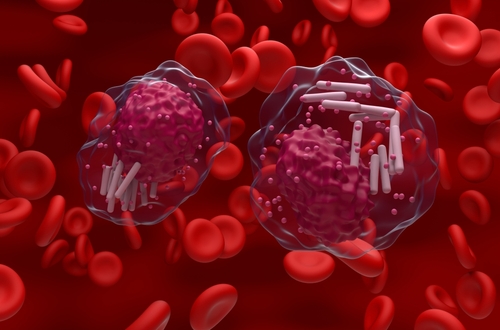
Patients who received chronic lymphocytic leukemia (CLL)- or small lymphocytic lymphoma (SLL)-directed treatment had a lower risk of Richter transformation (RT), according to a study presented at the 65th ASH Annual Meeting & Exposition, which is taking place December 9-12 in San Diego, California.
Paul J. Hampel, MD, and colleagues identified 3347 patients with previously untreated CLL/SLL in the Mayo Clinic CLL database who were seen within 12 months of diagnosis. The investigators used cumulative incidence methodology to correlate RT with death as a competing risk factor from both time of initial CLL/SLL diagnosis and start of CLL-directed therapy.
The researchers found that patients who received CLL/SLL treatment in the pre-novel agent (n=926) and novel agent (n=456) eras had subsequent 1-year incidence rates of RT of 0.3% (95% CI, 0.1%-1.0%) and 0.2% (95% CI, 0.0%-1.8%), with 5-year incidence rates of 3.7% (95% CI, 2.6%-5.2%) and 1.9% (95% CI, 0.7%-5.0%), respectively. While an increased risk of RT after CLL/SLL-directed therapy was observed in the pre-novel agent era compared with the novel agent era (hazard ratio, 2.4; 95% CI, 0.9-6.1; P=.07), those findings were not statistically significant.
“Patients who received CLL/SLL-directed treatment appear to have a lower risk of RT in the novel agent era. This may be driven by the fact that none of the patients who developed RT in the novel agent era received chemoimmunotherapy. Whether novel agent use for CLL/SLL suppresses the development of RT or avoids the risk associated with cytotoxic chemotherapy-induced clonal evolution requires further study,” the researchers concluded.
Reference
Hampel P, Rabe K, Wang Y, et al. Incidence of Richter transformation in patients with chronic lymphocytic leukemia (CLL)/small lymphocytic lymphoma (SLL): a cohort study evaluating different therapeutic eras. Abstract #3271. Presented at the 65th ASH Annual Meeting & Exposition; December 9-12, 2023; San Diego, California.







 © 2025 Mashup Media, LLC, a Formedics Property. All Rights Reserved.
© 2025 Mashup Media, LLC, a Formedics Property. All Rights Reserved.